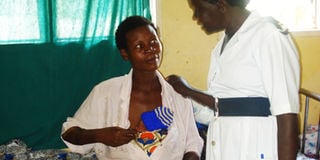Makerere takes child mortality fight to the east

KANGAROO STYLE: A health worker shows a mother how to keep a premature baby in Iganga District recently. PHOTO BY ZAHRA ABIGABA
Even after recording a number of deaths at childbirth, the government has not done much to address the issue. Now Makerere University School of Public Health is undertaking a survey in Iganga and Mayuge districts to find possible ways of averting the deaths, writes ZAHRA ABIGABA:-
Ms Fauza Namasene, 18, a resident of Nansinga-Bulamagi in Iganga District was seven months pregnant when she started bleeding. This was two months ahead the time she thought she would be giving birth. But when she was rushed to a clinic at Nakavule, she was hospitalised and a week later gave birth to a premature baby who weighed 1.4kg.
“With the help of the community worker my baby and I were saved,” Ms Namusene said. “They taught me how to look after my baby, how to clean the cord and how to keep the baby warm,” she added.
Mothers who give birth to premature babies put them on their chests to provide warmth for a certain period. Although Ms Namusene will live to talk about the good treatment she got, not so many pregnant women have the chance to be attended to by professionals. So many premature babies die at birth or days after due to poor management at child birth.
Conducting Survey
Because of such cases, Makerere University School of Public Health, with support from Saving Newborn Lives Project of Save the Children (USA), conducted a random study in the Iganga/Mayuge health demographic surveillance site.
The project which is intended to develop an integrated maternal-newborn care package links the community to health facilities. “If essential interventions reached all women of child-bearing age and newborns in Uganda, up to 31,800 newborn lives could be saved,” Dr Gakenia Wamoyu Maina, who works with the public health school at Makerere, says.
Every year about 3.7 million babies die in the first four weeks of life in Africa, according to the World Health Organisation. Most of these newborns are born in developing countries and most of them die at home. But two-thirds of all these deaths can be prevented if mother and newborns receive effective medical attention.
Home care
Studies have shown that home-based newborn care interventions can prevent 30-60 per cent of newborn deaths in high mortality settings under controlled conditions. With that recommendation home visits in the baby’s first week of life can improve newborn survival.
Information obtained from Save the Children Uganda, an NGO, indicates that an estimated 45,000 neonatal deaths and 45,100 stillbirths occur per year of which 31,800 could be saved by simple interventions proven to work. About 60 per cent of newborn deaths occur among babies born at home and the neonatal mortality rate is more than 20 per cent higher for rural families (Uganda Demographic Health Survey- 2006).
Major causes
Preventable causes dominate with infections accounting for an estimated 30 per cent of causes of neonatal deaths, followed by asphyxia (27 per cent), and complications of preterm delivery (25 per cent).
Yet evidence shows that even without expensive neonatal care units, 15 to 32 per cent of neonatal deaths can be prevented through the promotion of a few low cost key practices: clean home delivery, hygienic cord care, thermal care, early and exclusive breastfeeding, community-based care for low birth weight (Darmstadt, Bhutta et al. 2005).
Dr Peter Waiswa, the research study coordinator, says that they need to invest to save newborns like they do on malaria and HIV/Aids and also newborns should be integrated into policy.
In Uganda, over 40,000 newborn deaths and a similar number of stillbirths occur per year. Unless substantial reduction in these deaths occurs, the Millennium Development Goal four - to reduce child mortality by two thirds by 2015 - will not be achieved, says Dr Waiswa.
The World Health Organisation identified 16 key practices and interventions such as providing delivery in a health facility, newborn resuscitation, warm care at birth, exclusive breastfeeding, and hygienic umbilical cord care that if properly used by all parents could reduce by 72 per cent. But these are currently not reaching most newborn babies in Africa.
Dr Waiswa investigated the delays which lead to newborn deaths, and the acceptability at community level of the evidence-based newborn care practices that are recommended by the World Health Organisation.
He found that whereas most globally recommended newborn care practices were acceptable to the local community in Uganda, a few such as delayed bathing and dry cord care, were not, and need local adaptation prior to implementation.
Dr Waiswa also found out that care practices for newborn babies were of poor quality, and most babies died because of delays at home related to inability of households to recognise sick newborns or deciding to seek for care from a health facility.
Lack of skill
In addition, health workers lacked skills in newborn care, and health facilities did not have the basic equipment, drugs and supplies needed for the care of newborn babies. Dr Waiswa recommends prioritising newborn health, and that implementation of evidence-based newborn interventions promoted by the World Health Organisation needs adaptation at the local context.
He also says health facilities should be strengthened in terms of health worker skills, equipment, drugs and supplies. He suggests that due to few qualified health workers, programmes should consider integrating lay people or community health workers to promote proper newborn care especially in hard-to-reach areas.



